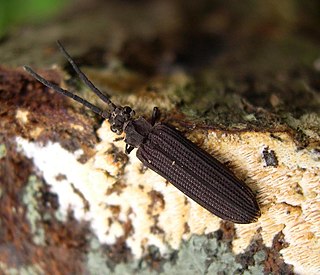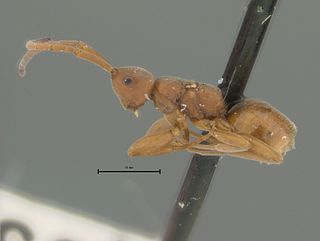
The Cupedidae are a small family of beetles, notable for the square pattern of "windows" on their elytra, which give the family their common name of reticulated beetles.

The family Gryllidae contains the subfamilies and genera which entomologists now term true crickets. They belong to the Orthopteran subfamily Ensifera, having long, whip-like antennae and has been reduced in terms of the older literature, with taxa such as the spider-crickets and allies, sword-tail crickets, wood or ground crickets and scaly crickets elevated to family level. The type genus is Gryllus and the first use of the family name "Gryllidae" was by Walker.

Green lacewings are insects in the large family Chrysopidae of the order Neuroptera. There are about 85 genera and 1,300–2,000 species in this widespread group. Members of the genera Chrysopa and Chrysoperla are very common in North America and Europe; they are very similar and many of their species have been moved from one genus to the other time and again, and in the nonscientific literature assignment to Chrysopa and Chrysoperla can rarely be relied upon. Since they are the most familiar neuropterans to many people, they are often simply called "lacewings". Since most of the diversity of Neuroptera are properly referred to as some sort of "lacewing", common lacewings is preferable.

The Cerophytidae are a family of Coleoptera known as the rare click beetles. Adults are infrequently encountered, and larvae are found within wood, where they are believed to feed on fungi. The family contains over 20 species in five genera, primarily distributed in the New World: 17 fossil genera are known extending to the Early Jurassic.

Mastotermitidae is a family of termites with one sole living species, Mastotermes darwiniensis which is found only in northern Australia. The remaining genera of this family are only known from the fossil record.

The Berothidae are a family of winged insects of the order Neuroptera. They are known commonly as the beaded lacewings. The family was first named by Anton Handlirsch in 1906.
Protorabinae is a subfamily of beetles in the family Carabidae. It contains 31 species in 10 genera:
Avitortor is an extinct fossil genus of beetle. Fossil specimens are poorly preserved and it is difficult to assign to any family.
Brochocoleus is an extinct genus of beetles in the family Ommatidae, known from the Early Jurassic to the Early Late Cretaceous. 9 species are currently recognised, with many species being reassigned to other genera by Kirejtshuk's major systematic revision in 2020.

Zygadenia is an extinct genus of beetles in the family Ommatidae.

Omma is a genus of beetles in the family Ommatidae. Omma is an example of a living fossil. The oldest species known, O. liassicum, lived during the final stage of the Triassic (Rhaetian), over 200 million years ago, followed by several other species from Europe and Asia until after O. attenuatum from the Lower Cretaceous, the genus then reappears in the Burmese amber during the Cenomanian, then disappears from the fossil record for the remaining 100 million years until today, with one species endemic to Australia, three other extant species that were formerly part of this genus were moved to the separate genus Beutelius in 2020. The extant Omma stanleyi is strongly associated with wood, being found under Eucalyptus bark and exhibiting thanatosis when disturbed. Its larval stage and many other life details are unknown due to its rarity. Males are typically 14-20 mm in length, while females are 14.4-27.5 mm. Omma stanleyi occurs throughout eastern Australia from Victoria to Central Queensland.

Embolemidae is a small family of around 64 species and 3 genera distributed around the world. They are small solitary parasitoid wasps, and are parasites on planthopper nymphs of the families Achilidae and Cixiidae.
Juraphididae is an extinct family of aphids in the order Hemiptera. There are at least three genera and about five described species in Juraphididae. The most recent discovery in Juraphididae family was the Prolavexillapis munditia in 2018 and Isolitaphidae are synonymy with the Juraphididae
Blattulidae is an extinct family of cockroaches known from the Triassic to the Late Cretaceous. Their distinguishing characteristics include "forewing has long Sc, regular venation with distinct intercalaries and hindwing has simple CuP, branched A1."
Mesoblattinidae is an extinct family of cockroaches known from the Mesozoic. It was formerly considered a wastebasket taxon for Mesozoic cockroaches, but the family has subsequently been better defined, with many taxa transferred to Caloblattinidae. It is considered to have close affinities with Blattidae and Ectobiidae, as well as possibly Blaberidae.
Umenocoleidae is an extinct family of dictyopteran insects known from the Cretaceous. The family was originally considered to be part of Coleoptera. They are considered to be closely related to the Alienopteridae within the superfamily Umenocoleoidea. Some species possess complex, cryptic colouration similar to those of the earliest flowers. A more recent analysis places Alienopteridae and Umenocoleidae as sister taxa within Dictyoptera, and not within Blattodea.

Allophalerus is an extinct genus of beetle in the family Ommatidae.

Eremochaetidae is an extinct family of brachyceran flies known from the Jurassic and Cretaceous periods of Asia. It is part of the extinct superfamily Archisargoidea. The morphology of the ovipositor of the only 3 dimensionally preserved genus Zhenia was initially interpreted as evidence of being an endoparasitoid of arthropods, however a subsequent study suggested that the ovipositor was used to deposit its eggs in plant material, similar to members of Tephritoidea. In a phylogenetic analysis, Ermochaetidae was found to be monophyletic, surrounded by a paraphyletic Archisargidae.
Praeaulacidae is an extinct family of Mesozoic parasitic wasps in the suborder Evanioidea. It among the earliest known families of the group and is characterised by more complete wing venation in comparison to other members of the suborder.
Angarosphecidae is an extinct family of Mesozoic and early Cenozoic wasps in the superfamily Apoidea.










